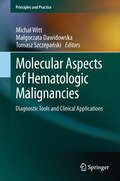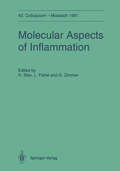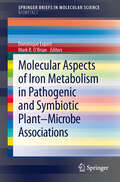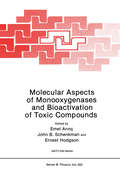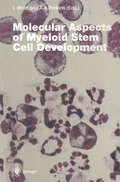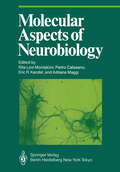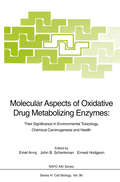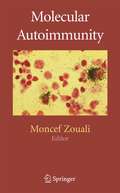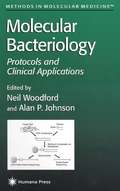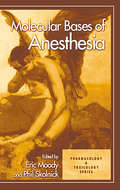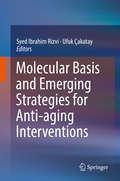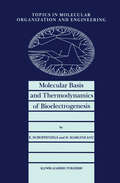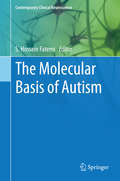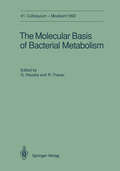- Table View
- List View
Molecular Aspects of Cancer and its Therapy (Molecular and Cell Biology Updates)
by A. Mackiewicz P. B. SehgalOn the basis of the agreement signed between UNESCO and the Government of the Republic of Poland the International Institute for Cell and Molecular Biology of UNESCO was officially inaugurated in October 1995 in Warsaw, Poland, as part of the activity of the Global Network for Molecular and Cell Biology (MCBN) of UNESCO. The occasion was marked by the bringing together in Warsaw of a broad spectrum of cell and molecular biologists from around the world under the auspices of the Global MCBN UNESCO. At the conclusion of that week-long celebration it became clear that Polish cell and molecular biology had come of age in terms of its depth, vigor and impact on the global scene. At the suggestion of Professor Angelo Azzi, chairman of Global MCBN UNESCO, we considered the challenge of compiling a volume in the Molecular and Cell Biology Updates tMCBU) Series that would address the molecular basis of cancer and its therapy, but one that would additionally serve to highlight Polish contributions to this field of research. We accepted the challenge presented to us by Professor Azzi and are grateful to all contributors of the present volume for making this a pleasant and stimulating project. We requested each contributor to present his personal perspective of respective topics. As a consequence, we hope that each contribution has a distinctive individual flavor which reflects the role played by individual research groups in advancing science.
Molecular Aspects of Chemotherapy: Proceedings of the Third International Symposium on Molecular Aspects of Chemotherapy Gdańsk, Poland June 19–21, 1991
by David Shugar Wojciech Rode Edward BorowskiWhile serendipity and random screening continue to fulfil a significant role in the search for new drugs, current remarkable advances in molecular biology and genetics are dictating to a profound extent the approaches employed in their development. Increasing attention is being devoted to investigations of the mechanisms of action of existing drugs, and the sources of undesired side effects, at the molecular level. The information so derived is now extensively applied, with the aid of broad inter disciplinary approaches, both theoretical and experimental, to improvements in existing drugs, and the rational design of new ones. The foregoing comprised the subject matter of the 3rd Inter national Symposium on "Molecular Aspects of Chemotherapy", under the auspices of the International Society of Chemotherapy, and organized by the Committee on Drug Research, Polish Academy of Sciences, and the Department of Biotechnology and Biochemistry, Technical University of Gdansk. This volume includes the texts of the review lectures presented by invited participants on up-to-date achievements, and future perspectives, in molecular mechanisms of inhibition of cellular functions and metabolism, with emphasis on the design and mechanisms of action of chemotherapeutic agents for treatment of bacterial, neoplastic, viral and parasitic diseases. From the Contents, it will be seen that the range of disciplines represented was a broad one, including theoretical and experimental chemists, physicists, molecular biologists, biochemists, enzymologists, virologists, tumour biologists. Plenary sessions were supple mented by several poster sessions.
Molecular Aspects of Hematologic Malignancies: Diagnostic Tools and Clinical Applications (Principles and Practice)
by Michal Witt, Malgorzata Dawidowska and Tomasz SzczepanskiThis book provides a state-of-the-art approach to the molecular basis of hematologic diseases and its translation into improved diagnostics and novel therapeutic strategies. Several representative hemato-oncologic malignancies are analyzed in detail: acute lymphoblastic leukemia, acute myeloid leukemia, B-cell Non-Hodgkin lymphomas, multiple myeloma, chronic lymphocytic leukemia, chronic myeloid leukemia, myelodysplastic syndromes, and myeloproliferative neoplasms. Experts in the field describe the molecular methods applied for modern diagnostics and therapies, such as hematopoietic stem cell transplantation, donor recipient matching, banking of biological material, analyses of post-transplant chimerism, and minimal residual disease monitoring. The volume concludes with an extensive section comprising thorough step-by-step protocols of molecular techniques in hematology, all of them validated in the authors’ own laboratories.
Molecular Aspects of Human Cytomegalovirus Diseases (Frontiers of Virology #2)
by E. S. HuangIn this book the current knowledge on human cytomegalovirus (HCMV) as a human pathogen is lucidly summarized, bringing the reader fully up to date with current knowledge concerning HCMV and all the known clincial and medical aspects of diseases caused by, and associated with, HCMV. The book is divided into four parts: (I) Human cytomegalovirus and human diseases; (II) human cytomegalovirus infections and the immunocompromised host; (III) diagnosis, treatment, and prevention of human cytomegalovirus and human diseases; and (IV) molecular aspects of human cytomegalovirus. Each part is put together from chapters written by experts in the respective fields, providing basic medical and molecular knowledge in addition to more specific understanding of HCMV infections.
Molecular Aspects of Inflammation: 42. Colloquium der Gesellschaft für Biologische Chemie 11.-13. April 1991 in Mosbach/Baden (Colloquium der Gesellschaft für Biologische Chemie in Mosbach Baden #42)
by Helmut Sies Leopold Flohe Guido ZimmerMolecular Aspects of Iron Metabolism in Pathogenic and Symbiotic Plant-Microbe Associations (SpringerBriefs in Molecular Science)
by Dominique Expert and Mark R. O'BrianIron plays a key role in biology as essential cofactor of numerous proteins. However, since it is only slightly soluble its bioavailability can be readily compromised under aerobic conditions. Moreover, due to its ability to catalyze the generation of free radicals, iron can also be toxic. Thus, it doesn’t surprise that living organisms have developed sophisticated means for acquiring iron whilst tightly controlling the intracellular concentrations of this metal in response to environmental conditions. Also, the critical role of iron has long been acknowledged in host vertebrate-parasite relationships where both partners compete for the acquisition of this essential element and activate complex signaling cascades to control their iron homeostasis during infection. Following the great interest that the mechanisms regulating the acquisition of iron and the control of iron homeostasis have generated among researchers studying plant-pathogen and legume-rhizobia interactions, this book offers a comprehensive analysis of irons’ various roles in the plant-microbial associations. The introductory chapter stresses the essentiality of iron in biological systems. The second chapter surveys the abundance of information on iron’s pivotal role in microbial plant pathogenesis and defence. Finally, the third chapter reviews the advances in our understanding of iron metabolism in the rhizobia, soil bacteria able to establish a symbiotic association with legumes and carry out nitrogen fixation. Molecular Aspects of Iron Metabolism in Pathogenic and Symbiotic Plant-Microbe Associations is a valuable resource to microbiologists, pathologists and scientists interested in iron uptake and metabolism in microbial pathogenesis, rhizobia legume associations, and plant physiology and immunity.
Molecular Aspects of Monooxygenases and Bioactivation of Toxic Compounds (Nato Science Series A: #202)
by Emel Arinç John B. Schenkman Ernest HodgsonProceedings of a NATO ASI held in Çesme (Izmir), Turkey, August 27-September 7, 1989.
Molecular Aspects of Myeloid Stem Cell Development (Current Topics in Microbiology and Immunology #211)
by Linda Wolff Archibald S. PerkinsA workshop on "MOLECULAR ASPECTS OF MYELOID STEM CELL DEVELOPMENT" was held at the Historic Inns in Annapolis, MD during April 30-May 3, with approximately 70 persons attend ing. The enormous success of this meeting was attributable to the recent outburst of information generated from two areas of study: transcriptional regulation of developmentally important myeloid genes and molecular dissection of chromosomal abnormalities in human myeloid leukemias. It was reassuring that studies of normal myelopoiesis and abnormal myelopoiesis, as observed in dys plasias and neoplasia, are revealing several interrelated mechan isms of gene regulation. However, great challenges await us as we try to determine how these and other mechanisms in this intricate system orchestrate the ultimate fate of cells e. g. proliferation, differentiation or apoptosis. This volume of Current Topics in Micro biology encapsulates many of the key aspects of the workshop summarizing research over the past few years on the ontogeny and pathology of myeloid cells. Investigations into the complex process of normal myeloid cell . maturation were first made possible through development of in vitro clonigenic assays. These established the relationships of colony stimulating factors, interleukins and their combinations to the specific fates of myeloid progenitors derived from the bone , marrow and spleen. Molecular studies became feasible, however, through the later establishment of several cell culture systems in volving immortalized cells which, under the proper induction, could fairly accurately recapitulate the myelopoietic process.
Molecular Aspects of Neurobiology (Proceedings in Life Sciences)
by Rita Levi-Montalcini Pietro Calissano Eric R. Kandel Adriana MaggiThe past two decades may well become known as the golden era of neurobiology. This field, that in the first half of this century seemed far too complex to be investigated with the low resolution techniques available to the investigators, suddenly blossomed in the second half of the century into one of the most promising areas of biology, thanks to discoveries which took place practically simultaneously in most areas of neurobiological research. Here we mention only some of the most important: the discovery of the large number of neurotransmitters from monoamines to peptides, the identification of the mechanism of action of different agents through their binding to specific receptors, the recognition that neuro transmitters act most of the time through a second messenger, and the discovery that growth and differentiation of nerve cells depend on activation by the protein molecule; all these were recognized I!S specific growth facts, of which the NGF was both the frrst to be dis covered and the object of the most intensive investigation. Recently, the development of highly sophisticated techniques such as recombinant DNA and monoclonal antibodies has been suc cessfully applied at the cellular and subeellular level to the study of nerve cells, neuronal cell population, and to the mechanism of their interaction. Studies pursued with the collaboration of different investigators all over the world have opened a new panorama of the tremendous complexity of the CNS, from the neuron to the whole organism.
Molecular Aspects of Neurodegeneration, Neuroprotection, and Regeneration in Neurological Disorders
by Akhlaq A. FarooquiMolecular Aspects of Neurodegeneration, Neuroprotection, and Regeneration in Neurological Disorders presents readers with comprehensive and cutting-edge information on the neurochemical mechanisms of various types of neurological disorders. The book covers information on signal transduction processes associated with neurochemistry of neurological disorders, including neurodegenerative, neurotraumatic, and neuropsychiatric disorders. The book also discusses risk factors, symptoms, pathogenesis, biomarkers, and the potential treatments of neurological disorders. The comprehensive information in this monograph may not only help in early detection of various neurological disorders, but will also promote the discovery of new drugs. - Provides a comprehensive overview of the molecular aspects of neurodegeneration, neuroprotection, and neuro-regeneration, along with therapeutic strategies for various types of neurological disorders - Provides cutting-edge research information on the signal transduction processes associated with the neurochemistry of neurological disorders - Discusses risk factors, symptoms, pathogenesis, biomarkers, and the potential for treatments of neurological disorders
Molecular Aspects of Oxidative Drug Metabolizing Enzymes: Their Significance in Environmental Toxicology, Chemical Carcinogenesis and Health (Nato ASI Subseries H: #90)
by Emel Arinc John B. Schenkman Ernest HodgsonPresented here are recent advances in biochemical, toxicological, and regulatory aspects of oxidative drug metabolizing enzymes. Mainly cytochrome P450-dependent and flavin-containing monooxygenases (FMO) are covered. Moreover, the book deals with genotoxicity studies and toxicological interactions of environmental chemicals and mechanisms of mutagenicity and tumor formation. The construction of genetically engineered mammalian cells for the production of a specific P450 isozyme and the application of these cell lines in drug metabolism, mutagenicity and toxicity studies are described in detail. Further, insight is provided into how a number of aquatic species cope with pollutants and their genotoxicity.
Molecular Aspects of Papovaviruses (Developments in Molecular Virology #9)
by Y. AloniIt is almost twenty years since the first DNA tumor virus meeting was held at Cold Spring Harbor. At this meeting studies on three tumor viruses were discussed: the papovaviruses, the adenoviruses and the herpesviruses. The present series Developments in Molecular Virology chose to reverse this sequence by first publishing books on the herpesviruses, followed by adenoviruses, and only now the papo vaviruses. All the DNA tumor viruses gained their original reputation by serving as model systems in animal cells for studying gene expression and gene regulation, but SV40 and polyoma have been the jewel in the crown in these studies, as A phage was for the study of prokaryotes. SV40 was the first DNA tumor virus to be completely sequenced that enabled the definition of the cis controlling elements in DNA replication and transcription. I am continuously fascinated by the organization of the SV40 and polyoma genomes. Although they contain about 5000 bp that encode for only 6 to 7 proteins, the mechanisms which regulated their gene expression are varied and include almost any other type of gene regulation found today to regulate eukaryotic genes. Just to mention two: (i) the early promoter is a classical promoter that contains the TAT A, CAAT and enhancer elements, while the late promoter is devoid of these elements, and (ii) the mRNA can be structurally and functionally monocistronic or dicistronic. This hints at the versatility in the control of gene expression at the transcriptional and translational levels.
Molecular Aspects of the Stress Response: Chaperones, Membranes and Networks (Advances in Experimental Medicine and Biology #594)
by Peter Csermely László VíghThis book makes a novel synthesis of the molecular aspects of the stress response and long term adaptation processes with the system biology approach of biological networks. Authored by an exciting mixture of top experts and young rising stars, it provides a comprehensive summary of the field and identifies future trends.
Molecular Autoimmunity
by Moncef Zouali2004 marks the 100th anniversary of the first description of the autoimmune disease paroxysmal cold hemoglobinuria, a rare hemolytic disorder, by Julius Donath and Karl Landsteiner. After a century of research, the list of autoimmune diseases has become impressive. With a prevalence of approximately 5% of the world-wide population, these chronic, debilitating conditions affect almost every major organ of the body and, for reasons that remain unclear, are much more prevalent in woman than in men. Despite our rapidly expanding knowledge of the cellular and molecular pathways that govern a normal immune response, deciphering the precise etiology of autoimmune diseases remains an important challenge. Over the last few years, our understanding of the pathogenesis of autoimmune diseases has improved rapidly, leading to the emergence of elegant immunointervention strategies. Molecular Autoimmunity illustrates how cutting-edge research is continuing to advance our understanding of autoimmune disease mechanisms and identifies novel therapeutic targets that provide a hope for effective future treatments. This volume contains a selected number of exciting advances in unraveling autoimmune reactions, and the resulting new armory of experimental immunotherapies that may lead to new ways of controlling autoimmune reactions.
Molecular Bacteriology: Protocols And Clinical Applications (Methods in Molecular Medicine #15)
by Neil Woodford and Alan P. JohnsonThe enormous advances in molecular biology that have been witnessed in . Not recent years have had major impacts on many areas of the biological sciences least of these has been in the field of clinical bacteriology and infectious disease . Molecular Bacteriology: Protocols and ClinicalApplications aims to provide the reader with an insight into the role that molecular methodology has to play in modern medical bacteriology. The introductory chapter ofMolecular Bacteriology: ProtocolsandCli- cal Applications offers a personal overview by a Consultant Medical Microbio- gist of the impact and future potential offered by molecular methods. The next six chapters comprise detailed protocols for a range of such methods . We believe that the use of these protocols should allow the reader to establish the various methods described in his or her own laboratory. In selecting the methods to be included in this section, we have concentrated on those that, arguably, have greatest current relevance to reference clinical bacteriology laboratories; we have deliberately chosen not to give detailed protocols for certain methods, such as multilocus enzyme electrophoresis that, in our opinion, remain the preserve of specialist la- ratories and that are not currently suited for general use. We feel that the methods included in this section will find increasing use in diagnostic laboratories and that it is important that the concepts, advantages, and limitations of each are th- oughly understood by a wide range of workers in the field .
Molecular Bases of Anesthesia
by Eric Moody Phil SkolnickMolecular Bases of Anesthesia provides a clear overview of the state of knowledge about anesthetic mechanisms at the molecular level of occurrence and focusing on the latest state-of-the-art techniques that relate to how anesthetic drugs cause unconsciousness. With contributions by leading experts, this timely book includes chapters on how
Molecular Basis and Emerging Strategies for Anti-aging Interventions
by Syed Ibrahim Rizvi Ufuk ÇakatayThis book describes the nature of aging, age-related disorders, and the molecular principles of emerging strategies for anti-aging interventions, while also discussing the discovery of targets for geroprotective drugs. Although significant medical advances in the treatment and eradication of life-threatening conditions such as cardiovascular and infectious disease have been made over the past five decades, the prevalence of age-related disorders still remains high in older populations. Intervening into aging is the next frontier in contemporary medicine, and will be of increasing importance over time, as other sources of poor health are combated more and more successfully. Given the universal interest in anti-aging strategies, the book will appeal to a very broad audience. It addresses a diverse range of anti-aging interventions – including stem cells, autophagy, senolytics, anti-inflammatory methods, and telomerase induction – that will be of interest to scientists and researchers from various disciplines in the life sciences.
Molecular Basis and Thermodynamics of Bioelectrogenesis (Topics in Molecular Organization and Engineering #5)
by E. Schoffeniels D. G. MargineanuDespite the fact that many years have elapsed since the first microcalorimetric measurements of an action potential were made, there is still among the research workers involved in the study of bioelectrogenesis a complete overlooking of the most fundamental principle governing any biological phenomenon at the molecular scale of dimension. This is surprising, the more so that the techniques of molecular biology are applied to characterize the proteins forming the ionic conducting sites in living membranes. For reasons that are still obscure to us the molecular aspects of bioelectrogenesis are completely out of the scope of the dynamic aspects of biochemistry. Even if it is sometimes recognized that an action potential is a free energy-consuming, entropy-producing process, the next question that should reasonably arise is never taken into consideration. There is indeed a complete evasion of the problem of biochemical energy coupling thus reducing the bioelectrogenesis to only physical interactions of membrane proteins with the electric field: the inbuilt postulate is that no molecular transformations, in the chemical sense, could be involved.
Molecular Basis for Microcirculatory Disorders
by Geert W. Schmid-Schönbein D.Neil GrangerA large number of cardiovascular diseases are accompanied by inflammation. This volume on the molecular basis of microcirculatory disorders gives a comprehensive summary of key steps in the inflammatory cascade. Leading investigators present a state-of-the-art analysis of the molecular determinants of leukocyte-endothelial cell adhesion, mechanotransduction in endothelial and inflammatory cells, mechanisms of cell activation, microvascular apoptosis with applications to ischemia-reperfusion in the brain, the heart and in venous disease, diabetes and hypertension. The book provides the latest thinking in these important cardiovascular problems, with the most contemporary literature and a look at the increasingly complex events during inflammation. Molecular biology tools, microvascular and modern bioengineering analysis are seamlessly integrated into the analysis of clinical problems. The book helps not only newcomers to gain entry into the interesting problems associated with microvascular disorders, but lays the foundation for the design of new therapeutic interventions.
Molecular Basis for Therapy of AIDS-Defining Cancers
by Dirk P. Dittmer Susan E. KrownCancer incidences increase in people living with HIV/AIDS. Over 2 million people currently live with HIV/AIDS in the US. This number will increase as HAART prolongs the average lifespan and as (at least in some states) the number of new HIV infections increase again. As this population ages their incidence rates for cancer will increase, as well. Recently, new rational targets for cancer therapy have emerged. But their application to the care of HIV+ patients is slow, because of concerns about the weakened immune status of the patients, because of possible drug interactions with HAART and because some of the AIDS defining cancer are rare.
The Molecular Basis of Autism (Contemporary Clinical Neuroscience)
by S. Hossein FatemiThis book is a comprehensive overview of the clinical and scientific aspects of Autism from the leading experts in the field. The clinical section covers everything from epidemiological features to epigenetic regulation to behavioral therapies and much in between. The basic science section presents the latest knowledge on the underlying causes of the disorder including the role of various neurotransmitters, neurexins and neuroligins, reelin, and other proteins. Chapters also explore the cognition and motor control in autism and the connection between oxidative stress and mitochondrial dysfunction and autism. The thorough description of these underlying causes may help researchers and clinicians find more effective treatments and therapies for the 1 in 68 American children who have been diagnosed with Autism.
The Molecular Basis of Bacterial Metabolism: 41. Colloquium, 5.-7. April 1990 (Colloquium der Gesellschaft für Biologische Chemie in Mosbach Baden #41)
by Günter Hauska Rudolf K. ThauerThe present volume contains 17 lectures of the 41 st Mosbach Colloquium of the Gesellschaft fiir Biologische Chemie, held from April 5-7, 1990 on the topic "The Molecular Basis of Bacterial Metabolism". From the beginning it was not the intention of the organizers to present a comprehensive account, but rather to select new, exciting progress on sometimes exotic reactions of specifically bacterial, mainly anaerobic metabolism. Members of our society had contributed to this progress to an extent that greatly stimulated the scientific exchange with international colleagues during the days in Mosbach. The editors hope that this stimulation will be conveyed to the readers of the articles, which reach from the biochemistry of methanogenesis, via anaerobic radical reactions, metal biochemistry in hydrogen and nitrogen metabolism, conversions of light - and redox energy, to the regulation of metabolic adaptation, and the attempts to bioengineer novel pathways for the degradation of xenobiotica. We believe that the book represents a highly progressive field of over lapping disciplines, comprising microbiology and molecular genetics, chemistry of biomimetic interest, and biophysics, and that it gives insight into the impact modern technologies have on microbiological research today. The colloquium was generously supported by the Deutsche Forschungsgemeinschaft, the Paul-Martini-Stiftung, and the Fonds fiir Biologische Chemie. A. Trebst, G. Schafer, and D. Oesterhelt were a great help in preparing the program and we wish to thank them for their advice.
Molecular Basis of Breast Cancer: Prevention and Treatment
by Jose Russo Irma H. RussoThis richly-illustrated atlas-like book provides a foundation for the biological and molecular understanding of how the mammary gland develops and how breast cancer originates. The main goal is to comprehensively review in ten chapters fundamental knowledge in breast cancer. New paradigms are described in which induction of differentiation in the mammary gland can promote prevention and cure of breast cancer. The text is extremely helpful both for clinicians treating patients and researchers looking for new avenues of development.
The Molecular Basis of Cancer E-Book: Expert Consult - Online
by John Mendelsohn Peter M. Howley Mark A. Israel Joe W. Gray Craig B. Thompson2015 BMA Medical Book Awards Highly Commended in Oncology Category!The Molecular Basis of Cancer arms you with the latest knowledge and cutting-edge advances in the battle against cancer. This thoroughly revised, comprehensive oncology reference explores the scientific basis for our current understanding of malignant transformation and the pathogenesis and treatment of this disease. A team of leading experts thoroughly explains the molecular biologic principles that underlie the diagnostic tests and therapeutic interventions now being used in clinical trials and practice. Detailed descriptions of topics from molecular abnormalities in common cancers to new approaches for cancer therapy equip you to understand and apply the complexities of ongoing research in everyday clinical application. - Effectively determine the course of malignancy and design appropriate treatment protocols by understanding the scientific underpinnings of cancer. - Visually grasp and retain difficult concepts easily thanks to a user-friendly format with abundant full-color figures. - Find critical information quickly with chapters following a logical sequence that moves from pathogenesis to therapy. - Stay current with the latest discoveries in molecular and genomic research. Sweeping revisions throughout include eight brand-new chapters on: Tumor Suppressor Genes; Inflammation and Cancer; Cancer Systems Biology: The Future; Biomarkers Assessing Risk of Cancer; Understanding and Using Information About Cancer Genomes; The Technology of Analyzing Nucleic Acids in Cancer; Molecular Abnormalities in Kidney Cancer; and Molecular Pathology. - Access the entire text and illustrations online, fully searchable, at Expert Consult.
Molecular Basis of Chronic Myeloproliferative Disorders
by H. L. PahlSince the first description of Philadelphia chromosome-negative chronic myeloproliferative disorders more than 100 years ago, the diagnosis and therapy of these conditions have been based primarily on clinical experience and judgement. Until recently very little was known about the molecular basis of these diseases. In order to spark research in this area basic scientists and clinicians from various parts of the world have contributed to this volume, the first of its kind to put together the current knowledge. The book deals with the new WHO classification of these disorders, novel aspects of diagnostic pathology, the search for disease-relevant genes utilizing molecular biology and proteomic techniques, the description of the roles of PVR-1 and VHL genes for polycythemias and the discovery of the gene mutation responsible for the idiopathic hypereosinophilic syndrome. A chapter on anagrelide, an important novel drug for the treatment of primary thrombocythemia, is included.


